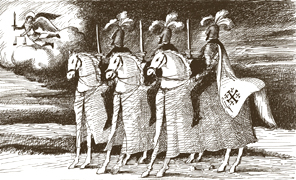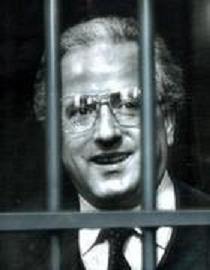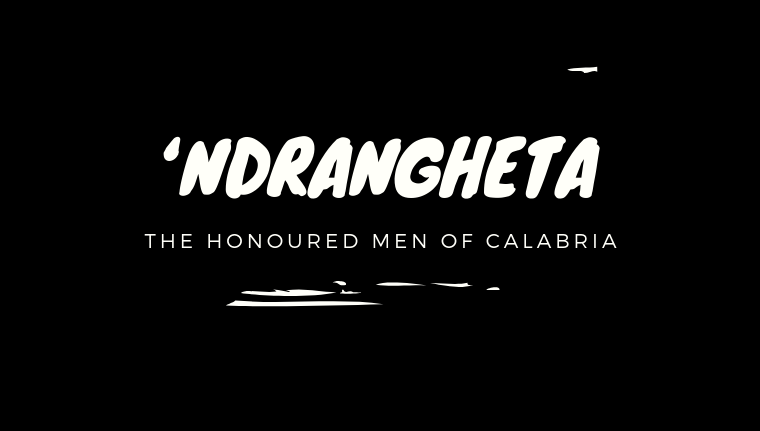A conspiracy can be defined as such when those who are members of it use the threatening power of the associative bond and the condition of subjection and the code of silence deriving from it, to commit crimes, to directly or indirectly acquire the management or control of financial activities, concessions, authorizations, contracts and public services to get unjust profit or advantages for oneself or other people, that is to prevent free voting practice or obtain votes for oneself or other people during elections.
(Crespi, Stella, and Zuccalà 2006)
The legend of Osso, Mastrosso and Carcagnosso is said to have begun in 15th century Spain. Toledo in central Spain was home to an organisation founded in approx. 1412 and called La Garduña. The members of this society followed a certain code of ethics and a powerful bond towards religion.

The sister of the brothers; Osso, Mastrosso and Carcagnosso, was raped by a man under protection of the king of Spain. The three brothers in an act of revenge killed the man. They were found guilty of murder and sent to Favignana, one of the Sicilian Islands. Belonging to the kingdom of Aragon, an autonomous community in north-eastern Spain.
The three worked hard to establish the rules of a new society, together they wrote secret codes; initiation and affiliation rites, and entire manuals of rules and disciplines. They devoted themselves to Jesus Christ, St. Michael the Archangel and Saint Peter, who holds the keys to open all the doors. It is said they stayed in prison for approx. 30 years.
Once released, the three brothers swore on the sacred code of the family and then went their separate ways. Osso stayed in Sicily and created ‘The Honoured Men of Sicily’ (La Cosa Nostra), Mastrosso and Carcagnosso both crossed the Messina Strait to mainland Italy. Mastrosso made his home in Calabria and was responsible for ‘The Honoured Men of Calabria’ (‘Ndrangheta) and Carcagnosso ‘The Honoured Men of Campania’ (Camorra).
There are few organisations that can boast a turnover larger than some European countries. The approx. £30 billion revenue is the sort of figure Croatia would be proud of as a GDP. However, not only does the revenue not belong to a country, it belongs to an organised crime group who has its origins in the southern regions of Italy, the ‘Ndrangheta (pronounced ehn-drann-ghetta). But what do we know of one of the youngest of Italy’s Mafia groups?
The youngest of the four Italian organised crime groups is Sacra Corona Unita (SCU) created in 1981 by the then Camorra boss Raffaele Cutolo.

Giuseppe Rogoli soon replaced Cutolo. They allege Rogoli was initiated and sanctioned as the boss of the SCU on Christmas Day 1983, whilst in prison on the coast of Bari. Included in the ceremony were some heavy hitting members of one of the most powerful clans in the ‘Ndrangheta, the Bellocco ‘Ndrina. The ‘Ndrangheta stayed local to Calabria with the usual Mafia rackets of extortion, protection, loan-sharking and smuggling, mainly cigarettes. This would change sometime around the late 70s early 80s. ‘Ndrangheta have now become a force to be reckoned with. Not just in Italy, but worldwide. As was so infamously announced in Duisburg in May 1993.
“The Duisburg massacre was like a geyser. A bubbling and deadly jet that from a slit of the ground has thrown upwards, finally visible to all, the miasmatic and extremely dangerous liquid of a crime that starting from the most remote depths of Calabria, had long spread everywhere in the dark underground of globalization. ” (Annual report on the ‘Ndrangheta, President of the anti-mafia parliamentary commission, Francesco Forgione February 20, 2008)
“The killing of six Italians in the German city of Duisburg has thrust into the spotlight the shadowy world of the ‘Ndrangheta, whose tentacles have spread far beyond their rural origins in Calabria, in southern Italy. The six men, one of whom was reported to be only 16 years old, were sprayed with machine gun bullets moments after they left a pizzeria in the western German city. Based on the strong blood ties between interlinked families, membership of the ‘Ndrangheta – which means “Honoured Society” – is believed to number in the tens of thousands.
“It is disturbing – firstly because of the sheer number of dead,” the acting director of Italy’s National Anti-Mafia bureau, Carmelo Petralia, told the BBC news website. He said Italy had been aware for some time of how the ‘Ndrangheta was using its business activities in Germany to launder the proceeds of its criminal activities at home, far from the prying eyes of the Italy’s mafia investigators. “We knew that the ‘Ndrangheta had deep links to Germany, and that these were connected to money laundering,” Mr Petralia said.” (http://news.bbc.co.uk/1/hi/world/europe/6949274.stm. Accessed 06/07/2019)
An ‘Ndrina is the name given to the clan or a family – the structure of ‘Ndrangheta is quite a complex and one with many levels, I will try to provide the best basic overview I can – A father (or mother sometimes) as the boss with his brothers, sisters, sons, daughters, nieces, nephews and cousins working for him. Each ‘Ndrine is then attached to a ‘Locale’, these are made up of the ‘Societá Minore (junior members) and ‘Societá Maggiore (higher/greater members). The minor ranks are bestowed titles known as ‘doti/fiori’ (gifts/flowers) ‘giovane d’onore’ (honoured youth), ‘picciotto’ (lad), ‘camorrista’ (racketeer in translation) and ‘camorrista di sgarro’ (a camorrista also up for the fight). Titles that stay with the recipient forever. The province of Reggio Calabria, the home of ‘Ndrangheta, comprises 3 ‘mandamenti’ (commandment in translation but to mean district in this context). Each one of the 3 mandamenti is controlled by an ‘il gran crimine’ (head/boss of crime of the district). Next are the upper echelons of ‘Ndrangheta, here you have the major society and on to the senior ranks finishing with the ‘padrino’ (The main man. The overall boss. The Godfather).
The De Stefano family are another family considered being a powerful clan of ‘Ndrangheta. Giorgio De Stefano was head of the family, when a major fall out – over the share of profits that would come from the new steelworks being built in Gioia Tauro–would start the First ‘Ndrangheta war of 1974-76. On November 24, 1974, the De Stefano brothers Giorgio and Giovanni were dining at the Roof Garden in the piazza Indipendenza, Reggio Calabria, when two gunmen walked in and began shooting at the brothers. Giorgio’s brother Giovanni died at the scene, and although badly injured, Giorgio survived the attack. Three years later, after 233 murders, an uneasy truce was called, and the war ended. This truce would soon be tested. On 7th November 1977, Giorgio, on his way to a meeting in Santo Stefano in Aspromonte, was shot and killed. The remaining brother, Paolo, now head of the family, was informed that the man who killed his brother, Giuseppe Suraci, had done so over a personal feud. Suraci had been beheaded, so it was difficult for him to talk, and it later emerged the hit had been ordered by their allies of the first war, the Piromallis.
The ‘Second ‘Ndrangheta’ which lasted 1985 to 1991. The bloody war was between the De Stefano/Tegano/Libri/Latella clans and the Condello/Imerti/Serraino/Rosmini clans and led to the deaths of more than 600. Following the end of the war, ‘La Provincia’ was created. La provincia, also known as ‘Camera di Controllo’ (board of control), was like ‘The Commission’ of La Cosa Nostra (Sicilian Mafia). It is said that the Sicilian Mafia helped broker the peace and suggested the creation of la provincial. Since the 90s, as an organisation, ‘Ndrangheta invested heavily in the drug trade, globally, their chief supply, cocaine, coming direct from Colombia. They have reported it that ‘Ndrangheta handle 85% of the cocaine entering Europe. Buying kilos of cocaine for as little as 1,000 euros and selling for around 30,000 euros a kilo.
This translated news report published January 2019 from Catanzaro, of the Calabria region shows the numbers of ‘Ndrangheta in just those areas.
“There are 166 criminal organizations in Calabria that have over 4000 affiliates of which 2000 are located in the district of Catanzaro. These are the data provided by the president of the Court of Appeal of Catanzaro Domenico Introcaso during the inauguration ceremony of the judicial year. A “sprawling” ndrangheta, said in his report the president of the Court of Appeal of Reggio Calabria Luciano Gerardis, “infiltrated in all social categories, predominant in the economy, with different and serious violations of the law and with serious distortions of the labor market, causing degenerative effects in the management of many public bodies, with the consequent distortion of every merit-based selection criterion “.”
(https://web.archive.org/web/20190223182740/http://www.ansa.it/calabria/notizie/2019/01/26/ndrangheta-tentacolare-166-le-cosche_045e2ebe-3809-4b50-852d-5d6fdb30d16b.html. Accessed 07/07/19) ANSA AGENCY – daily intervals – Registration in the Press Register at the Court of Rome n. 212/1948 P.I. IT00876481003 – © Copyright ANSA – All rights reserved.
- Ciro Dapagio’s MobKing: Trailer & Review - July 24, 2023
- LUCKY: A True Crime Graphic Novel - April 25, 2023
- The Theft of The Marlborough Diamond – Chapter 2 - February 14, 2023








